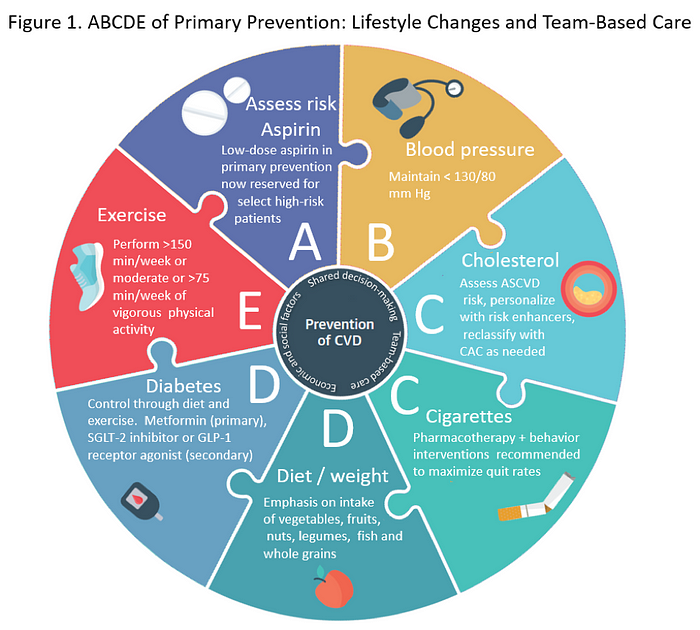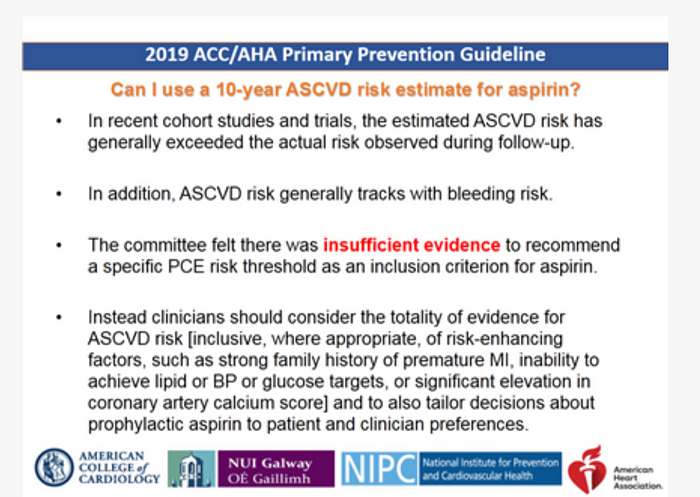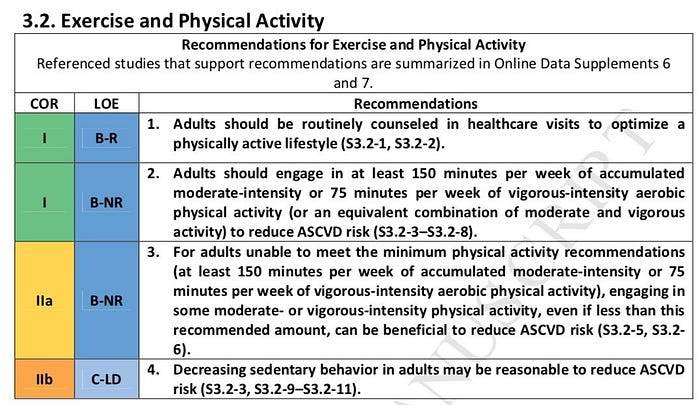Understanding the New 2019 ACC/AHA Guideline on the Prevention of Cardiovascular Disease in Under 5 Minutes

The headlines were worldwide: “aspirin no longer useful for stroke and heart attack prevention”.
The source of the buzz was the new guidelines issued this week from a joint American College of Cardiology and American Heart Association (ACC/AHA) guideline just published. The new guideline is geared exclusively for primary prevention. Anyone with known clinically significant atherosclerotic vascular disease (ASCVD) is excluded from this guideline as their care is classified as “secondary prevention”. One might think that the only topic in the guideline was aspirin use for the primary prevention of heart attack and stroke. Indeed, the recommendations involved other important topics that are summarized here in text and pictures. But first a few comments on aspirin.
Aspirin Use for Primary Prevention
As above, aspirin therapy is strongly recommended for secondary prevention in patients with known heart disease like a prior stent, a heart attack, bypass operation, carotid operation, peripheral procedure like an aneurysm repair, or known significant narrowings in arteries. In general, in patients with a history of these conditions, the benefits of aspirin in reducing cardiovascular problems outweigh the risks. Chief among these risks is a very small risk of bleeding in the brain, and a small risk of life-threatening bleeding from the stomach.
The ACC/AHA guidelines suggest that most adults without a history of heart disease should not take low-dose daily aspirin to prevent a first heart attack or stroke, particularly if over 70 years old (chart 4.6 below). Based on 3 new studies, the ASPREE, ARRIVE, and ASCEND trials, the ACC/AHA guidelines concluded that the risk of side effects from aspirin, particularly bleeding, outweighed the potential benefit.

A gray area are patients with evidence of silent atherosclerosis such as a high coronary artery calcium score (CACS) by CT imaging. As shown below on the 4th bullet point, this is a decision that is to be individualized for each patient. I favor an 81 mg aspirin in patients without a bleeding history but who have a CACS over 100 or have carotid narrowing of 25% or more.

The role of CACS was indicated in the guidelines as of value for many patients as indicated in the table below. The recommendation to consider a CACS before starting a statin medication to determine if a zero score is present (and avoid the statin) would impact tens of millions of persons if implemented fully.

Top 10 Take-Home Messages for the Primary Prevention of Cardiovascular Disease
1. The most important way to prevent atherosclerotic vascular disease, heart failure, and atrial fibrillation is to promote a healthy lifestyle throughout life.
2. A team-based care approach is an effective strategy for the prevention of cardiovascular disease. Clinicians should evaluate the social determinants of health that affect individuals to inform treatment decisions.
3. Adults who are 40 to 75 years of age and are being evaluated for cardiovascular disease prevention should undergo 10-year atherosclerotic cardiovascular disease (ASCVD) risk estimation and have a clinician–patient risk discussion before starting on pharmacological therapy, such as antihypertensive therapy, a statin, or aspirin. In addition, assessing for other risk-enhancing factors can help guide decisions about preventive interventions in select individuals, as can coronary artery calcium scanning.
4. All adults should consume a healthy diet that emphasizes the intake of vegetables, fruits, nuts, whole grains, lean vegetable or animal protein, and fish and minimizes the intake of trans fats, processed meats, refined carbohydrates, and sweetened beverages. For adults with overweight and obesity, counseling and caloric restriction are recommended for achieving and maintaining weight loss.
5. Adults should engage in at least 150 minutes per week of accumulated moderate-intensity physical activity or 75 minutes per week of vigorous-intensity physical activity.
6. For adults with type 2 diabetes mellitus, lifestyle changes, such as improving dietary habits and achieving exercise recommendations, are crucial. If medication is indicated, metformin is first-line therapy, followed by consideration of a sodium-glucose cotransporter 2 inhibitor or a glucagon-like peptide-1 receptor agonist.
7. All adults should be assessed at every healthcare visit for tobacco use, and those who use tobacco should be assisted and strongly advised to quit.
8. Aspirin should be used infrequently in the routine primary prevention of ASCVD because of lack of net benefit.
9. Statin therapy is first-line treatment for primary prevention of ASCVD in patients with elevated low-density lipoprotein cholesterol levels (≥190 mg/dL), those with diabetes mellitus, who are 40 to 75 years of age, and those determined to be at sufficient ASCVD risk after a clinician–patient risk discussion.
10. Nonpharmacological interventions are recommended for all adults with elevated blood pressure or hypertension. For those requiring pharmacological therapy, the target blood pressure should generally be <130/80.
Physical Fitness
The headlines overlooked the strong evidence for the role of physical fitness in ASCVD prevention. Also overlooked was as little as 11 minutes a day or 75 minutes a week of vigorous-intensity aerobic physical activity satisfied the guidelines. My elliptical has a 14 minute HIIT program built in that would qualify as a daily dose of exercise.

Nutrition
No Virginia, there are no diet wars, just outliers that have limited or absent data. As recommended below by the ACC/AHA guidelines, the core foods for the prevention of ASCVD are patterned after the Mediterranean diet and are low or absent in saturated fat sources like meat, cheese, butter, full fat dairy, and coconut oil and are rich in vegetables, fruits, legumes, nuts, whole grains, and fish (a food I omit). Processed meats, refined carbs, added sugars and trans-fats are all to be avoided.

Conclusions
The choices we make every day can have a lasting effect on our heart and vascular health. Adopting a heart healthy eating plan early in life, getting more exercise, avoiding tobacco and managing known risk factors are among the key recommendations in the 2019 Primary Prevention of Cardiovascular Disease guideline from the ACC/AHA. Also, it is recommended that aspirin should only rarely be used to help prevent heart attacks and stroke in people without known cardiovascular disease.
